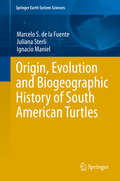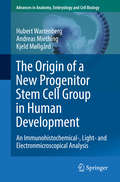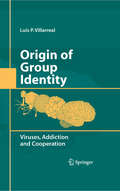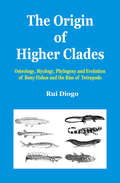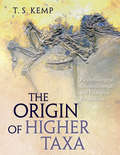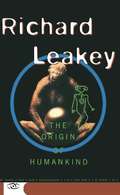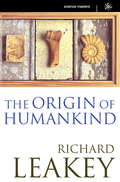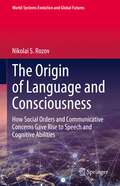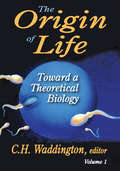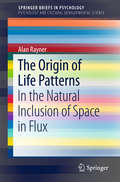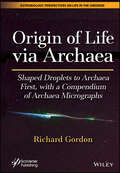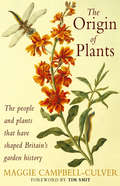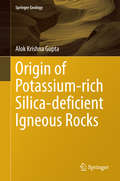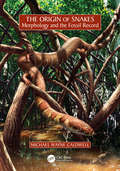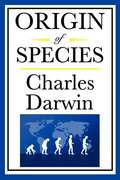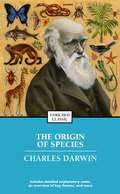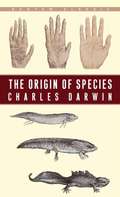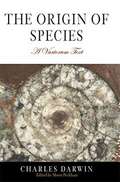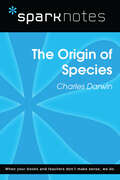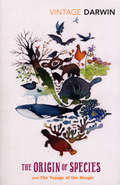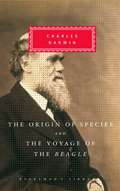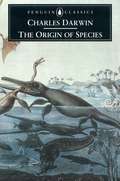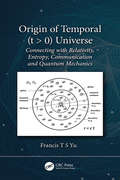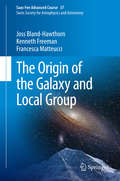- Table View
- List View
Origin, Evolution and Biogeographic History of South American Turtles
by Marcelo S. Fuente Juliana Sterli Ignacio ManielThe extended continental South American turtle record (Norian to Lujanian) allows us to follow the evolution of this reptile clade from its origins. Several significant stem turtle taxa such as: Palaeochersis talampayensis and Condorchelys antiqua provide information on the first steps of turtle evolution. Others such as: Chubutemys copelloi or Patagoniaemys gasparinae provide clues to the origin of the bizarre horned tortoises of the clade Meiolaniidae. The panpleurodiran species such as Notoemys laticentralis or Notoemys zapatocaensis shed light on the origin of modern pleurodiran turtles. This book explores aquatic and terrestrial cryptodiran turtles, South Gondwana pleurodiran turtles, North Gondwana pleurodiran turtles; Meiolaniforms and early differentiation of Mesozoic turtles.
The Origin of a New Progenitor Stem Cell Group in Human Development: An Immunohistochemical-, Light- And Electronmicroscopical Analysis (Advances In Anatomy, Embryology And Cell Biology Ser. #230)
by Hubert Wartenberg Andreas Miething Kjeld MøllgårdThis book presents an overview of a new group of progenitor stem cells. Their origins were originally detected in light- and electron microscopical sections of plastic embedded human embryonal and fetal organs. The distribution of these cells can result in a large quantity of ectopic stem cells. The observation of these ectopic stem cells leads us to postulate the existence of a basic wave of stem cell progenitors. This process proceeds earlier and independently from germ cell migration. This first wave of progenitor stem cell migration initially reaches the peri-aortal AMG-region (Aortal-Mesonephric-Gonadal region). From here, some of these progenitor cells enter the aorta, are distributed through the vascular system and become the embryonal stem cells (reserve cells) in many peripheral tissues. A second part delivers progenitor cells for the adrenal 'anlage'. Within the peripheral Zona definitiva of the adrenal cortex the progenitor cells multiplicate and subsequently leave the adrenal cortex through a gate of the capsule. The progenitor cells arrive at the pre-aortal sympathic plexus ('second brain'). Within the plexus ganglia they form new organ-like clusters, the paraganglia. In a second process the progenitor cells (Chromaffine cells) enter sympathetic nerve bundles. Here an 'axonal migration' starts, which guides the progenitor cells to several peripheral organs. During this migration process the stem cells develop into their final state. In the adrenal cortex the ingrowing nerves guide the stem cells to the adrenal medulla. In the pancreas the ingrowing nerve fibers guide the stem cells to the islets. These newly detected stem cells represent a specific developmental step which is found only in humans.
Origin of Group Identity
by Luis P. VillarrealThe molecular evolution of viruses is fascinating and quite controversial, relevant to the evolution of living organisms, a determinant in pathogenesis by viruses, and amenable to detailed study in various laboratories around the globe. Evolution is the product of variation and selection. Genetic recombination is a major source of variation for evolutionary selection. Full understanding of virus evolution requires knowledge of the inventory of existing viruses, their distribution in biological space and time and their interactions with other viruses and living organisms. The basic focus of this volume will be to trace the evolution (or accumulation) of biological identity systems from molecules to microbes, through animals to primate and human social structure. Overall, the volume will be organized so that it will trace the evolution of group identification systems from simple unicellular life forms, through the 'tree of life' all the way to complex hominid social structures. Such an evolutionary tracing has not been previously published, thus the book will develop and present a unique organization of information. The focus of this book will also be to understand the mechanisms that allow group (social) identification and communication systems to function. Sensory identification systems, especially receptors, will be emphasized. In unicellular and early multicellular organisms, addiction modules (toxins and antitoxins, often from genetic parasites) are most commonly used as biological group identification systems. Later in evolution, odor receptors, in particular, provide a clear evolutionary trail that can be followed from microbes to humans. Photo and visual receptors are also considered along with the neurological systems that process receptor information. Visual and audio based social imprinting will also be presented. In addition, the book will seek to understand the underlying evolutionary forces that drive the creation of group identification systems. In particular, 'addiction' based molecular strategies will be examined. A unique element of this book will be to evaluate the role of genetic parasites in the origination of such addiction modules. The recent explosion of genomic databases and information will be called on heavily as evidence for this part of the book.
The Origin of Higher Clades: Osteology, Myology, Phylogeny and Evolution of Bony Fishes and the Rise of Tetrapods
by Rui DiogoThe book provides insight on the osteology, myology, phylogeny and evolution of Osteichthyes. It not only provides an extensive cladistic analysis of osteichthyan higher-level inter-relationships based on a phylogenetic comparison of 356 characters in 80 extant and fossil terminal taxa representing all major groups of Osteichthyes, but also analyses various terminal taxa and osteological characters. And also provides a general discussion on issues such as the comparative anatomy, homologies and evolution of osteichthyan cranial and pectoral muscles, the development of zebrafish cephalic muscles and the implications for evolutionary developmental studies, the origin homologies and evolution of one of the most peculiar and enigmatic structural complexes of osteichthyans, the Weberian apparatus, and the use of myological versus osteological characters in phylogenetic reconstructions.
The Origin of Higher Taxa
by T. S. KempIn the grand sweep of evolution, the origin of radically new kinds of organisms in the fossil record is the result of a relatively simple process: natural selection marching through the ages. Or is it? Does Darwinian evolution acting over a sufficiently long period of time really offer a complete explanation, or are unusual genetic events and particular environmental and ecological circumstances also involved? With The Origin of Higher Taxa, Tom Kemp sifts through the layers of paleobiological, genetic, and ecological evidence on a quest to answer this essential, game-changing question of biology. Looking beyond the microevolutionary force of Darwinian natural selection, Kemp enters the realm of macroevolution, or evolution above the species level. From the origin of mammals to the radiation of flowering plants, these large-scale patterns--such as the rise of novel organismal design, adaptive radiations, and lineage extinctions--encompass the most significant trends and transformations in evolution. As macroevolution cannot be studied by direct observation and experiment, scientists have to rely on the outcome of evolution as evidence for the processes at work, in the form of patterns of species appearances and extinctions in a spotty fossil record, and through the nature of species extant today. Marshalling a wealth of new fossil and molecular evidence and increasingly sophisticated techniques for their study, Kemp here offers a timely and original reinterpretation of how higher taxa such as arthropods, mollusks, mammals, birds, and whales evolved--a bold new take on the history of life.
The Origin of Higher Taxa: Palaeobiological, Developmental, and Ecological Perspectives
by T.S. KempIn the grand sweep of evolution, the origin of radically new kinds of organisms in the fossil record is the result of a relatively simple process: natural selection marching through the ages. Or is it? Does Darwinian evolution acting over a sufficiently long period of time really offer a complete explanation, or are unusual genetic events and particular environmental and ecological circumstances also involved? With The Origin of Higher Taxa, Tom Kemp sifts through the layers of paleobiological, genetic, and ecological evidence on a quest to answer this essential, game-changing question of biology. Looking beyond the microevolutionary force of Darwinian natural selection, Kemp enters the realm of macroevolution, or evolution above the species level. From the origin of mammals to the radiation of flowering plants, these large-scale patterns—such as the rise of novel organismal design, adaptive radiations, and lineage extinctions—encompass the most significant trends and transformations in evolution. As macroevolution cannot be studied by direct observation and experiment, scientists have to rely on the outcome of evolution as evidence for the processes at work, in the form of patterns of species appearances and extinctions in a spotty fossil record, and through the nature of species extant today. Marshalling a wealth of new fossil and molecular evidence and increasingly sophisticated techniques for their study, Kemp here offers a timely and original reinterpretation of how higher taxa such as arthropods, mollusks, mammals, birds, and whales evolved—a bold new take on the history of life.
The Origin of Humankind: Unearthing Our Family Tree
by Richard Leakey"The name Leakey is synonymous with the study of human origins," wrote The New York Times. The renowned family of paleontologists--Louis Leakey, Mary Leakey, and their son Richard Leakey--has vastly expanded our understanding of human evolution. <P><P>The Origin of Humankind is Richard Leakey's personal view of the development of Homo Sapiens. At the heart of his new picture of evolution is the introduction of a heretical notion: once the first apes walked upright, the evolution of modern humans became possible and perhaps inevitable. From this one evolutionary step comes all the other evolutionary refinements and distinctions that set the human race apart from the apes. In fascinating sections on how and why modern humans developed a social organization, culture, and personal behavior, Leakey has much of interest to say about the development of art, language, and human consciousness.
The Origin Of Humankind (SCIENCE MASTERS)
by Richard Leakey Richard E. LeakeyA meticulously clear account of how early ape-men of the African savanna developed into fully human beings.Leakey has always been interested in far more than the mere physical features presented by fossils, and here he is particularly concerned with non-tangible human attributes, such as art, language and consciousness itself.Leakey's personal involvement in many of the key discoveries of hominid fossils, and his friendships and rivalries with his fellow fossil hunters, add more than a dash of spice to his narrative."An outstanding account of our current understanding of human evolution" Sunday Times"An elegant summary of what is currently known about human evolution" Observer
The Origin of Language and Consciousness: How Social Orders and Communicative Concerns Gave Rise to Speech and Cognitive Abilities (World-Systems Evolution and Global Futures)
by Nikolai S. RozovThis book presents an evolutionary theory of the origin and step-by-step development of linguistic structures and cognitive abilities from the early stages of anthropogenesis to the Upper Paleolithic. Emphasizing the social nature of the human mind and using an extended version of C.Hempel's explanatory logic, the author proves that language and consciousness emerged and evolved through the daily efforts of our ancestors to overcome mutual misunderstandings in increasingly complex social orders with increasing tasks on memory, thinking, and normative regulation of behavior, with the addition of new and new communicative concerns.The book addresses questions such as the following:What unique social conditions led to the emergence of the first protosyllables and protowords?What steps enabled the crossing of the "linguistic Rubicon" (between animal communication and human speech)?Why were syllables and phonemes needed? How did our ancestors overcome the difficulties of misunderstanding?How, when, and why did ancient people learn to speak in turns? Why did they begin to talk about past and distant events? What is consciousness and how did it evolve along with language?How many original languages were there and why are there roughly 200 philas (language macrofamilies)?How and why did the number of languages and the degree of their complexity change in pre-written history?Did the Romance languages really evolve from Latin?Accordingly, the book will appeal to scholars in various disciplines who are interested in a better understanding of the cognitive aspects of anthropogenesis and the ancient origins of language and consciousness.
The Origin of Life
by Raymond AronTheoretical biology is still in its early stages as an academic discipline. There is even little agreement as to what topics it should deal with or in what manner it should precede; and it is only recently that philosophers felt called upon to notice the relevance of biological topics as evolution or perception to their traditional problems. This work is a publication of the International Union of Biological Sciences, the central organization of all the branches of biology. The main focus here is to explore the possibility of formulating some frame of concepts and methods around which theoretical biology can grow.The intention of this collective effort was that discussions would be concerned, not with the theory of particular biological processes, such as membrane permeability, genetics, and neural activity, but rather with an attempt to discover and formulate general concepts and logical relations characteristic of living as contrasted with inorganic systems. Further, this project is a consideration of implications these might have for general philosophy. Many well-known scientists contributed to this volume, such as J. Maynard Smith, Ernst Mayr, Brian Goodwin, and Renu Thom.The Origin of Life: Toward a Theoretical Biology explores the character of the problems facing any theory of general biology. It contains a series of chapters and exchanges discussing such topics as the origin of life, cellular differentiation, morphogensis, evolution, and indeterminacy in biological and physical systems, the organization of the brain, the statistical mechanics of non-linear oscillators, and many other topics. This is a pioneering volume by recognized leaders in an emerging field the first of four such works.
The Origin of Life Patterns
by Alan RaynerUnderstanding the relationship between human cultural psychology and the evolutionary ecology of living systems is currently limited by abstract perceptions of space and boundaries as sources of definitive discontinuity. This Brief explores the new understandings possible when space and boundaries are perceived instead as sources of receptive continuity and dynamic distinction between local identities and phenomena. It aims to identify the recurrent patterns in which life is expressed over diverse scales in natural ecosystems and to explore how a new awareness of their evolutionary origin in the natural inclusion of space in flux can be related to human cultural psychology. It explains why these patterns cannot adequately be represented or understood in terms of conventional logic and language that definitively isolates the material content from the spatial context of natural systems. Correspondingly, the Brief discusses how the perception of natural space as an infinite, intangible, receptive presence, and of natural informational boundaries as continuous energetic flux, revolutionizes our understanding of evolutionary processes. The mutual natural inclusion of receptive space and informative flux in all distinguishable local phenomena enables evolutionary diversification to be understood as a fluid dynamic exploration of renewing possibility, not an eliminative 'survival of the fittest'. Self-identity is recognized to be a dynamic inclusion of natural neighborhood, not a definitive exception from neighborhood. The Origins of Life Patterns will be of interest to psychologists, philosophers, anthropologists, evolutionary biologists, ecologists, mathematicians, and physicists.
Origin of Life via Archaea: Shaped Droplets to Archaea First, with a Compendium of Archaea Micrographs (Astrobiology Perspectives on Life in the Universe)
by Richard GordonThis book surveys the models for the origin of life and presents a new model starting with shaped droplets and ending with life as polygonal Archaea; it collects the most published micrographs of Archaea (discovered only in 1977), which support this conclusion, and thus provides the first visual survey of Archaea. Origin of Life via Archaea’s purpose is to add a new hypothesis on what are called “shaped droplets”, as the starting point, for flat, polygonal Archaea, supporting the Vesicles First hypothesis. The book contains over 6000 distinct references and micrographs of 440 extant species of Archaea, 41% of which exhibit polygonal phenotypes. It surveys the intellectual battleground of the many ideas of the origin of life on earth, chemical equilibrium, autocatalysis, and biotic polymers. This book contains 17 chapters, some coauthored, on a wide range of topics on the origin of life, including Archaea’s origin, patterns, and species. It shows how various aspects of the origin of life may have occurred at chemical equilibrium, not requiring an energy source, contrary to the general assumption. For the reader’s value, its compendium of Archaea micrographs might also serve many other interesting questions about Archaea. One chapter presents a theory for the shape of flat, polygonal Archaea in terms of the energetics at the surface, edges and corners of the S-layer. Another shows how membrane peptides may have originated. The book also includes a large table of most extant Archaea, that is searchable in the electronic version. It ends with a chapter on problems needing further research. Audience This book will be used by astrobiologists, origin of life biologists, physicists of small systems, geologists, biochemists, theoretical and vesicle chemists.
The Origin Of Plants: The People And Plants That Have Shaped Britain's Garden History
by Maggie Campbell-CulverA fascinating history of Britain's plant biodiversity and a unique account of how our garden landscape has been transformed over 1000 years, from 200 species of plant in the year 1000 to the astonishing variety of plants we can all see today. Thousands of plants have been introduced into Britain since 1066 by travellers, warriors, explorers and plant hunters - plants that we now take for granted such as rhododendron from the Far East, gladiolus from Africa and exotic plants like the monkey puzzle tree from Chile.Both a plant history and a useful reference book, Maggie Campbell-Culver has researched the provenance and often strange histories of many of the thousands of plants, exploring the quirky and sometimes rude nature of the plants, giving them a personality all of their own and setting them in their social context. The text is supported by beautiful contemporary paintings and modern photographs in 2 x 8 pp colour sections.
Origin of Potassium-rich Silica-deficient Igneous Rocks (Springer Geology)
by Alok Krishna GuptaThe book summarizes the occurrence, geochemistry, mineralogy, petrology and phase-equilibria studies in air and under high pressures related to the most intriguing group of potassium-rich mafic and ultramafic rocks, often including host of exotic mineral assemblages including feldspathoids. Mantle-derived K-rich melts had intrigued most of the founders of Geology and many of the later experts in the field of Igneous Petrology, because they are sometimes associated with carbonatites and even diamond. They tend to contain anomalous concentration of many such elements as K, Rb, Sr, U, F, P, etc., along with Ni, Co and Cr indicating a mixture of crust and mantle materials. Although these rocks occur rarely in ancient geologic time, they have been erupting mostly in modern geological history (less than last 120 Ma or so). Are the old age data real or the result of a sampling problem? Modern observations leave no doubt that sediments must be subducted on a large scale. There is now evidence that the upper mantle (and perhaps even the lower mantle) is not homogeneous but rather like a fruit cake, and that there are thermal anomalies in the mantle resulting from deep mantle plumes or subduction. Is this related to release of these unusual rocks clearing the mantle of left over subduction materials? This volume, written for those interested in the geochemistry of K-rich melts from the deep Earth, reviews the present state of knowledge of these unique igneous rocks. The author is an expert in the field of Igneous Petrology and the book will serve as a valuable reference book for researchers and academicians in the discipline.
The Origin of Snakes: Morphology and the Fossil Record
by Michael Wayne CaldwellThis book presents perspectives on the past and present state of the understanding of snake origins. It reviews and critiques data and ideas from paleontology and neontology (herpetology), as well as ideas from morphological and molecular phylogenetics. The author reviews the anatomy and morphology of extant snakes. Methods are also critiqued, including those empirical and theoretical methods employed to hypothesize ancestral ecologies for snakes. The modern debate on squamate phylogeny and snake ingroup phylogeny using molecules and morphology is examined critically to provide insights on origins and evolution. Key Features Important major evolutionary transformation in vertebrate evolution Continuing historical debate in vertebrate paleontology Of wide interest to a core audience of paleontologists, herpetologists, and morphologists Author acknowledged as prominent contributor to debate over snake origins Based on remarkable well preserved fossil specimens
Origin of Species
by Charles DarwinThe Origin of Species is the landmark book that, for better or worse, puts science and religion at odds. Very few people have read this book and come away not believing in evolution. The detail of research is even by today's standards stunning; and the writing is still eminently readable. Second only to the Bible in its scope of influence, this book is a pertinent today as when it was first written.
The Origin of Species: V11 Harvard Classics (Enriched Classics)
by Charles DarwinThis classic work of scientific literature, presenting the theory of evolution by means of natural selection, is still both relevant and controversial in the twenty-first century. THIS ENRICHED CLASSIC EDITION INCLUDES: A concise introduction that gives the reader important background information A chronology of the author's life and work A timeline of significant events that provides the book's historical context An outline of key themes to guide the reader's own interpretations Detailed explanatory notes Critical analysis, including contemporary and modern perspectives on the work Discussion questions to promote lively classroom and book group interaction A list of recommended related
The Origin of Species
by Charles DarwinTo celebrate the 150th anniversary of the publication of Charles Darwin's seminal 1859 work introducing the theory of evolution by natural selection, science writer and journalist Quammen presents the first edition text richly augmented by more than 350 images including historical photos and portraits, Darwin's own drawings, images of the places he went, the people he saw, the creatures he encountered, and the ship he traveled on. An informative introduction and extensive reproductions from The Voyage of the Beagle (Darwin's research travel narrative) as well as brief excerpts from his biography, diaries, and correspondence provide added perspective on who the man really was, how he came to develop his revolutionary theory, and how one of the most important and controversial books in history came to be. Annotation ©2009 Book News, Inc., Portland, OR (booknews.com)
The Origin of Species: A Variorum Text
by Charles Darwin Morse PeckhamThe theories propounded by Charles Darwin in The Origin of Species have had a profound and revolutionary effect, not only on biology but also on philosophy, history, and theology. His concept of natural selection has created eruptive disputes among scientists and religious leaders of his time and ours. The phenomenal importance of his brilliant work is universally recognized, but the present volume marks the first scholarly attempt to compile a complete variorum edition of The Origin of Species, covering all of the extensive variants in the six texts published between 1859 and 1872. Darwin's changes were extensive. His book grew by a third as he rewrote many passages four or five times, and in this edition Morse Peckham has recorded every one of those changes. A book of such distinctive dimensions, on a subject of such profound importance, will be of intense interest to historians of biology, evolution, science, literature, and cultural development. It will be an invaluable aid to the clarification and full comprehension of this complex and renowned scientific classic.
The Origin of Species (SparkNotes Literature Guide Series)
by SparkNotesThe Origin of Species (SparkNotes Literature Guide) by Charles Darwin Making the reading experience fun! Created by Harvard students for students everywhere, SparkNotes is a new breed of study guide: smarter, better, faster. Geared to what today's students need to know, SparkNotes provides: *Chapter-by-chapter analysis *Explanations of key themes, motifs, and symbols *A review quiz and essay topicsLively and accessible, these guides are perfect for late-night studying and writing papers
The Origin of Species and the Voyage of the Beagle: On The Origin Of Species, The Autobiography Of Charles Darwin, And The Voyage Of The Beagle
by Charles DarwinDiscover Charles Darwin's most important ideas... When the eminent naturalist Charles Darwin returned from South America on board the H.M.S Beagle in 1836, he brought notes and evidence that would form the basis of his landmark theory: that species evolve by a process of natural selection. This theory, published as The Origin of Species in 1859, is the basis of modern biology and the concept of biodiversity. It also sparked a fierce scientific, religious and philosophical debate that still rages today. WITH AN INTRODUCTION BY DARWIN'S GREAT-GREAT-GRANDDAUGHTER, RUTH PADEL
The Origin of Species and The Voyage of the 'Beagle': Introduction by Richard Dawkins
by Charles Darwin Richard Dawkins[Illustrated jacket] Introduced by Richard Dawkins. Easily the most influential book published in the nineteenth century, Darwin's The Origin of Species is also that most unusual phenomenon, an altogether readable discussion of a scientific subject. On its appearance in 1859 it was immediately recognized by enthusiasts and detractors alike as a work of the greatest importance: its revolutionary theory of evolution by means of natural selection provoked a furious reaction that continues to this day. The Origin of Species is here published together with Darwin's earlier Voyage of the 'Beagle.' This 1839 account of the journeys to South America and the Pacific islands that first put Darwin on the track of his remarkable theories derives an added charm from his vivid description of his travels in exotic places and his eye for the piquant detail.
The Origin of Species by Means of Natural Selection: Or the Preservation of Favoured Races in the Struggle for Life
by Charles DarwinWith his revolutionary work The Origin of Species Charles Darwin overthrew contemporary beliefs about Divine Providence and the beginnings of life on earth. Written for the general public of the 1850s, it is a rigorously documented but highly readable account of the scientific theory that now lies at the root of our present attitude to the universe. Challenging notions such as the fixity of species with the idea of natural selection, and setting forth the results of pioneering work on the ecology of animals and plants, it made a lasting contribution to philosophical and scientific thought.
Origin of Temporal (t > 0) Universe: Connecting with Relativity, Entropy, Communication and Quantum Mechanics
by Francis T.S. YuThe essence of temporal universe creation is that any analytical solution has to comply with the boundary condition of our universe; dimensionality and causality constraints. The essence of this book is to show that everything has a price within our temporal (t > 0) universe; energy and time. In mathematics, every postulation needs proof; there exists a solution before searching for the solution. Yet science does not have seem to have a criterion as mathematics does; to prove first that a postulated science exists within our temporal universe. Without such a criterion, fictitious science emerges, as already have been happening in every day’s event. In this book, the author has shown there exists a criterion for a postulated science whether or not it is existed within our universe. The author started this book from Einstein’s relativity to the creation of our temporal universe. He has shown that every subspace within our universe is created by energy and time, in which subspace and time are coexisted. The important aspect is that every science has to satisfy the boundary condition of our universe; causality and dimensionality. Following up with temporal universe, the author has shown a profound relationship with the second law of thermodynamics. He examines the relationship between entropy with science as well as communication with quantum limited subspace throughout the book. The author discusses the paradox of Schrödinger’s Cat (which has been debated by Einstein, Bohr, Schrödinger and many others since 1935) that triggered his discovering that Schrödinger’s quantum mechanics is a timeless machine, in which he has disproved the fundamental principle of superposition within our universe. Since quantum mechanics is a virtual mathematics, he has shown that a temporal quantum machine can, in principle, be built on the top of a temporal platform. This book is intended for cosmologists, particle physicists, astrophysicists, quantum physicists, computer scientists, engineers, professors and students as a reference and research-oriented book.
The Origin of the Galaxy and Local Group
by Joss Bland-Hawthorn Kenneth Freeman Francesca Matteucciben MooreThis volume contains the updated and expanded lecture notes of the 37th Saas-Fee Advanced Course organised by the Swiss Society for Astrophysics and Astronomy. It offers the most comprehensive and up to date review of one of the hottest research topics in astrophysics - how our Milky Way galaxy formed. Joss Bland-Hawthorn & Ken Freeman lectured on Near Field Cosmology - The Origin of the Galaxy and the Local Group. Francesca Matteucci's chapter is on Chemical evolution of the Milky Way and its Satellites. As designed by the SSAA, books in this series - and this one too - are targeted at graduate and PhD students and young researchers in astronomy, astrophysics and cosmology. Lecturers and researchers entering the field will also benefit from the book.
